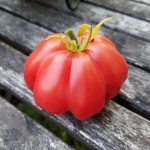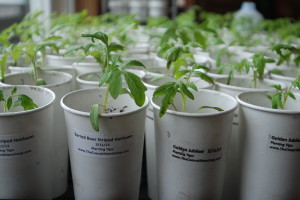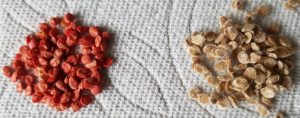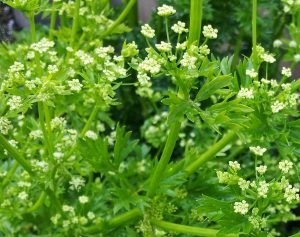It’s early March and I’m itching to start scratching in the dirt. Unfortunately, a good third of the garden is still under a blanket of snow and what’s not covered is frozen.
While you may not be able to garden outside, now is the perfect time to start warm-season crops inside. And given the weather, it may be a while before we can direct-sow those cool-season crops outside.
I start a variety of heirloom seeds (some are organic) inside about 8 weeks before the last average day of frost. But, no hybrids for me, and of course no GMOs!
Does it sound like I’m writing in a foreign language? The words in italics are just a few of terms you will come across in seed catalogs and on the back of seed packets. Here’s a helpful list of definitions to help you navigate through those catalogs and choose the seeds that best suit your needs and growing conditions.
Organic: This term is used to describe a product that has been produced without the use of synthetic fertilizers, pesticides, growth stimulants, or antibiotics. It does not mean the product has been grown without the use of these substances, as there are organic fertilizers and pesticides (produced from animal or plant sources), which are approved for organic farming and gardening practices.
Organic Seed: Certified organic seed is collected from plants that have been grown using only organic farming/gardening practices.
USDA Organic: The USDA organic seal certifies that the variety has been grown and processed in  accordance with the conditions of the Organic Foods Production Act. The USDA organic regulations describe organic agriculture as the application of a set of cultural, biological, and mechanical practices that support the cycling of on-farm resources, promote ecological balance, and conserve biodiversity.
accordance with the conditions of the Organic Foods Production Act. The USDA organic regulations describe organic agriculture as the application of a set of cultural, biological, and mechanical practices that support the cycling of on-farm resources, promote ecological balance, and conserve biodiversity.
Heirloom: An heirloom is a variety of plant that has been passed down through generations. Some heirlooms originating as far back as the 1800s are still grown today. Heirlooms are open-pollinated and reproduce true to type, meaning the seed will have the same genetic makeup as the parent plant. Seeds/plants are generally considered heirlooms if they were introduced into cultivation prior to 1951.
Open-pollinated: A plant/seed that is produced through natural pollination without breeding controls. Open-pollinated seeds will reproduce true to type and seeds can be saved from season to season.
Hybrid: Hybrids (also labeled as an F1), are produced by cross-pollinating two different inbred species. Seeds from a hybrid plant are not genetically stable and will not produce a plant with the same characteristics of the parent. Many hybrid plants have been developed for increased vigor and disease resistance. One important note, a hybrid is not a genetically modified organism (GMO).
GMO: A genetically modified organism (GMO) seed have been laboratory-engineered to contain genes from other lifeforms. These “crosses” would never occur outside the laboratory under natural conditions. GMO seed is not available to the general public for purchase.
Treated Seed: Seed that has been given an application of a chemical, often antimicrobial or fungicidal, to reduce, control or repel disease organisms, insects, or other pests. Treated seed are easy to identify by their unnatural color (usually red).
Wild-Crafted: Seed collected from wild plants growing in natural environments.
Annual: Plants that grow, mature, flower, produce seed, and die in one season.
Biennial: Plants that take two years, or a part of two years, to complete their life cycle. The first season of growth results in a small rosette of leaves near the soil surface. During the second season, the plant will elongate, flower and set seed, and then die.
Perennial: Plants that live more than two years and produce new foliage, flowers, and seeds each growing season. The top portion of the plant dies back each winter and regrows the following spring from the same root system.
Short-day Plants: These plants require more than 12 hours of continuous darkness to stimulate a change in growth (flowering). The June-bearing strawberry is an example, along with the poinsettia and chrysanthemum.
Long-day Plants: Require more than 12 hours of continuous daylight to stimulate a change in growth. Onions grown in northern latitudes are “long-day” varieties–they require longer days to produce a bulb. Short-day onion varieties are grown in southern latitudes–where there is less daylight.
Day-neutral Plants: These types of plants do need a specific amount of daylight to produce flowers/fruit. Certain strawberry cultivars are day-neutral.

Tomatoes are warm-season crops and should be started indoors, 6 to 10 weeks before the last average frost date.
Warm-season Crops: These plants need warm soil (at least 55 degrees) and warm ambient temperatures to germinate and grow outdoors. They are very susceptible to cold, wet growing conditions and are easily killed by frost. Examples include tomatoes, peppers, cucumbers, corn, melons, squash, and beans.
Cool-season Crops: These plants thrive in temperatures below 70 degrees and are often tolerant to frost. Most are planted in the early spring or late summer. Examples include spinach, kale, cabbage, carrots, and peas.
Planting Zones: The USDA plant hardiness zone map is the standard by which gardeners and growers can determine which plants are most likely to thrive at a location. Northern Idaho is in zone 6. . The map is based on the average annual minimum winter temperature.
Last Average Day of Frost: This is the last average day that you could expect to have a killing frost in the spring. For north Idaho, that date is usually around May 15th. You can plant warm-season crops after the danger of frost has passed. Similarly, the first average day of frost occurs in the fall, usually around September 20th for the Idaho panhandle.
Direct-sow/seed: Planting a seed directly into the soil. Some vegetables do not transplant well from starts and should only be seeded. Examples include root crops like carrots and beets, as well as beans and corn.
Days to Maturity/Harvest: Refers to the amount of time it will take for a plant to flower or produce fruit. It also depends on how the plant is seeded. For crops that are direct-seeded into the soil, like carrots, days to maturity refers to the time between planting the seed and harvesting the carrot. For crops that are started indoors and are then transplanted to the garden as seedlings, such as tomatoes, it refers to the time between transplanting and picking that first ripe, juicy, tomato.
 So flip open those seed catalogs and start making your list of garden prospects. I promise, spring will be here sooner or later!
So flip open those seed catalogs and start making your list of garden prospects. I promise, spring will be here sooner or later!





I would like a seedling start chart for zone 6 Idaho
Hi,
You can find the seed starting links for Northern Idaho/Eastern WA on our website here: https://thecoeurdalenecoop.com/seed-starting-charts/
We are classified as Zone 6, but our weather is more like Zone 5. What is listed on the charts is correct for our area.